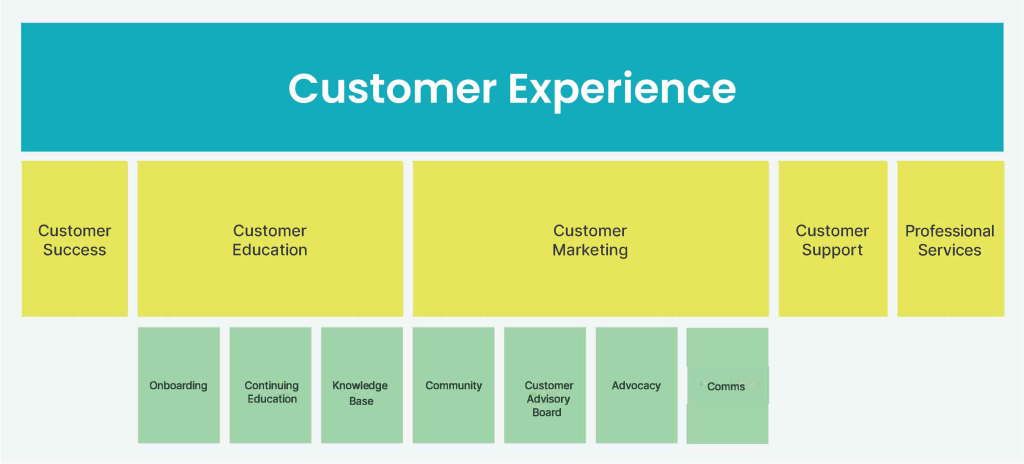A close partnership between marketing and customer education can be a game changer for both teams – not to mention your customers. This connection allows for a cohesive, seamless strategy to not only reach and engage clients, but also educate them on how to get the most value out of your product. Combining forces leads to a new superpower to market your customer education and dramatically broaden the reach of your training – resulting in higher satisfaction, retention, and advocacy gains across the board.
After working in this industry for 15 years, I’ve found that customer education, customer marketing, success, support, and professional services are all parts of the same engine of customer experience. Whether or not this is the actual organizational structure at your company, thinking of these teams and similar tasks as working alongside one another – rather than in siloed corners of the business – can be helpful to visualize an exceptional client experience.

Read on to find the shared goals these teams have in common, how they can leverage one another for support, and the impact this alignment can have on your customers.
Marketing and Customer Education Have the Same Obstacle
For both marketing teams and customer education, there’s an inherent issue that these teams need to build content or campaigns that will resonate with a wide audience. In other words, they both face a “one to many” challenge, and the answer lies in high quality learning content, plus engaging and compelling campaigns.
For customer marketing in particular, this team is trying to reach as many people as possible within the same audience base that customer education is targeting. In this way, customer marketing and customer education will likely find one another an invaluable source of audience information. Compare notes: What courses (and subject matter) are the largest numbers of customers interested in? Which campaigns have been the most successful? What’s the most common question or response to outreach?
For both of these teams, product adoption and customer retention are absolutely key. Training professionals will always tell you, “an educated customer is a happy customer.” Guiding as many customers toward that learning experience matters not only to the team that built that course, but to the entire organization. As the customer journey progresses, the more a customer understands and utilizes within our product, the more likely they are to become an expert user and an advocate for the brand. The more informed a customer is, the less the chance they’ll churn. How they get that information, and where it comes from, is really the question. And remember, a well-educated customer is more likely to provide positive word-of-mouth marketing, further increasing the product’s reach.
How Marketing and Customer Education Can Leverage One Another
The biggest benefit to a strong partnership between marketing and customer education is the new access for each team to new tools and resources.
For customer marketing, they have access to a wealth of information from the customer education team on how customers are actually using the product. This information can be used to create more targeted and effective marketing campaigns, as well as to identify potential areas for improvement in the product. Additionally, the customer education team may have access to tools, such as LMS, that the marketing team can use to create more engaging and interactive educational materials.
One of the strongest threads that can be built between customer education and marketing is through activities. You want to ensure that training is referenced frequently in every channel from customer newsletters to virtual events, to eLearning calendars. Weaving this thread throughout your customer marketing channels ultimately makes the community stronger and drives an impactful flow of information. Visibility in both directions – toward both your customer community and your learning experience – is a great way to keep customers highly engaged, up to date, and feeling like valued members of their cohort.
A Strong Customer Community Impacts The Entire Organization
By providing customers with a space to connect and engage with one another, as well as with your company, a community platform can foster a sense of belonging and investment among customers. This can lead to increased loyalty, cross-sells or upsells, and a greater sense of advocacy and engagement with your brand. Customer communities can also serve as a valuable source of feedback and insights, which can be used to improve both the product and the education or onboarding experience.
In the world of customer marketing, we have such a clear understanding that one of the strongest things we do is celebrate the customer. Celebration and public appreciation can lead your clients to become strong brand advocates, promoting the company to their own networks and helping to boost pipeline on your behalf. But customer celebration can happen for a lot of reasons. In a traditional sense it can spotlight how they’re using your product with a case study or a social media highlight. But we can also celebrate when a customer has achieved a learning milestone, like completing onboarding or earning a certification. Customer communities are a perfect channel for this outpouring of appreciation and support for your customers, by your customers.
Communities make relationships stronger.
Think about how you can leverage “1:many” to build stronger relationships with your customers.
Kristine Kukich is currently Senior Director of Customer Marketing at Thought Industries. She brings 15 years of SaaS experience in customer education with a focus on customer success. As a manager at Taleo, and a Principal Delivery Lead at Oracle University, she has aided customers to build skills and processes that help them work more effectively within their teams, within their organizations and with their clients.


